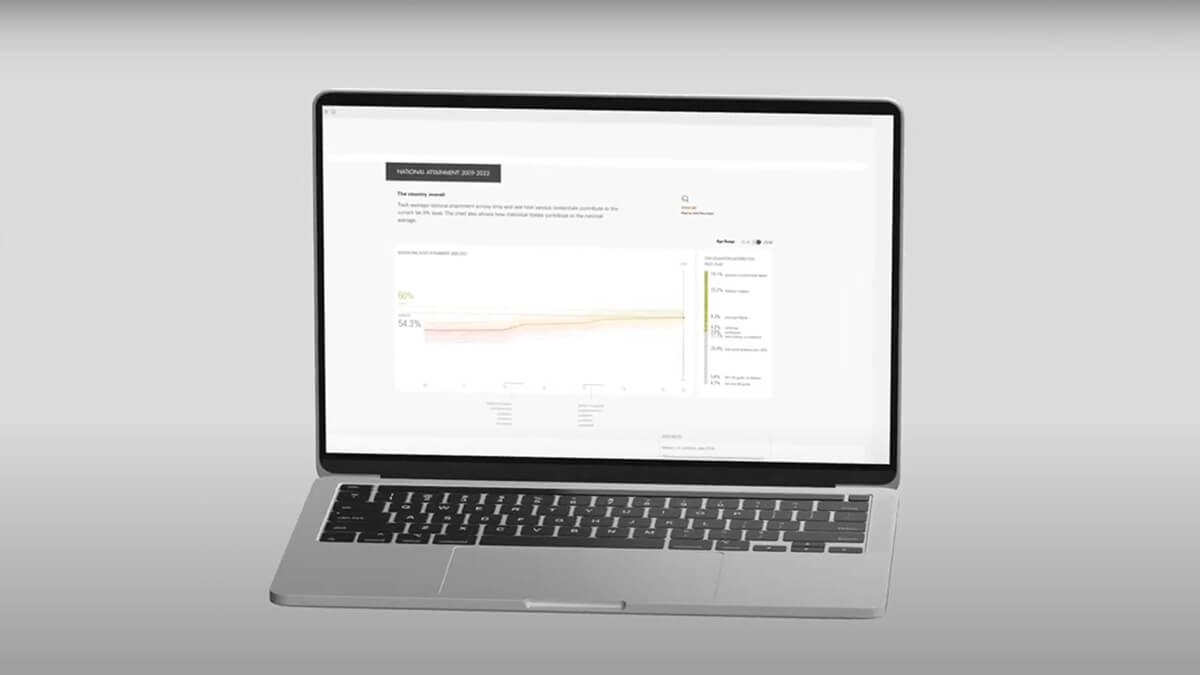Welcome to the era of data-driven transformation, where fresh insights pave the way to a brighter future. We recently unveiled new data in Lumina Foundation’s Stronger Nation tool, an interactive map guiding us toward our national goal of helping 75 percent of Americans earn college degrees or other quality credentials by 2040.
Even amid skepticism about the value of a college degree, we’ve achieved another year of remarkable progress in educational attainment, with a notable increase in Americans earning college degrees. This marks a significant milestone in our nation’s journey towards a more educated, informed, and highly skilled citizenry.
Here’s the proof: The U.S. has seen a staggering 16 percentage-point increase in attainment since 2009, from 38.1 percent to a proud 54.3 percent in 2022. States like Kentucky and Rhode Island lead the charge with strong 3.4 percentage point increases. Others, including Colorado, North Carolina, Alabama, Florida, and the District of Columbia, each exceeded 2 percentage points in growth.
But this isn’t just about numbers; it’s about the stories the numbers tell and their transformative impact on college students like Denia Beck and Miguel Contreras. And it’s about the nation pulling together to help people learn and earn. In 2009, only one state had an attainment goal; since then, 48 other states set goals. Thirty-five of those states notched 2022 increases in residents’ educational attainment beyond high school.
Progress and gaps
What’s driving this monumental shift? A key factor is the rising attainment of bachelor’s and associate degrees, with an impressive 8.5 percentage point rise over the past 14 years. In the past year alone, degree attainment has surged by almost a full percentage point. Equally inspiring is the notable increase in degree attainment among Black and Hispanic and Latino Americans, a testament to strides toward racial equity in education.
The outlook is especially promising among young adults ages 25-34. This demographic now boasts a 56.3 percent attainment rate, surpassing the full working-age population and reversing trends. Young Hispanic students, in particular, are pivotal in this transformation, with degree attainment soaring from about 19 percent in 2009 to over 33.5 percent in 2022.
Yet—significant equity gaps remain, with post-high school attainment rates among Black, Hispanic, Latino, and Native American adults falling significantly below the national average of 51.7 for White Americans. Black Americans are at 35.7 percent, followed by 29.5 percent for Hispanic and Latino adults, and 26.5 percent for Native Americans.
These gaps demand our attention and action. As we build a more educated and prosperous nation, we cannot leave out huge swaths of the population—including people of color, immigrants, and the rural working poor.
Which credentials pay off?
One other disappointing trend in the data demands our attention. Thirty states plus Puerto Rico and the District of Columbia saw declines in Americans with industry certifications and college certificates that provide significant wage increases. Stronger Nation only counts quality short-term credentials that lead to jobs paying at least 10 to 15 percent above work requiring only a high school diploma. So, this unusual decline in short-term credentials shows we must continue the challenging work of helping students understand which credentials lead to good jobs—and which do not.
A guiding light
Enter the Stronger Nation tool—an invaluable resource empowering individuals, communities, and states to drive change. With its wealth of data and insights, this tool serves as a guiding light, illuminating areas of success and opportunities for improvement. Whether it’s comparing communities, identifying underserved groups, or charting a course toward equity, the Stronger Nation tool is a catalyst for meaningful progress.
At Lumina Foundation, this is the work we tackle daily—a commitment to shaping a stronger nation filled with individuals equipped for success. As we navigate this journey together, it’s up to us to harness the power of data, collaboration, and unwavering dedication to transform aspirations into reality.
So, I invite you to explore the Stronger Nation website—it’s free and easily accessible!—to join us in our mission to create a future where everyone has opportunities to thrive. Together, we can build a stronger, more educated nation where good jobs and good lives are within reach for all.
The path is clear, the opportunity is vast, and the time for action is now.
